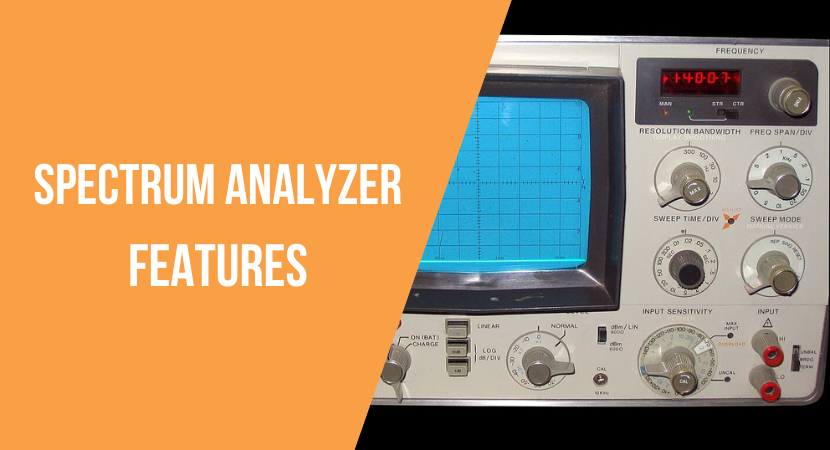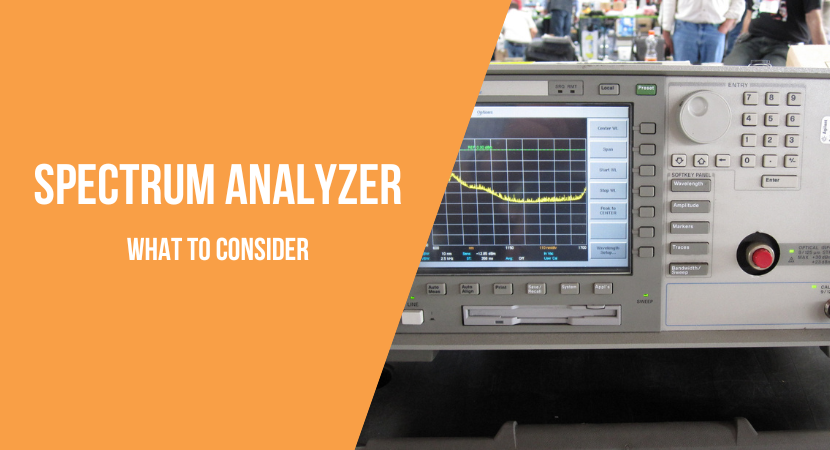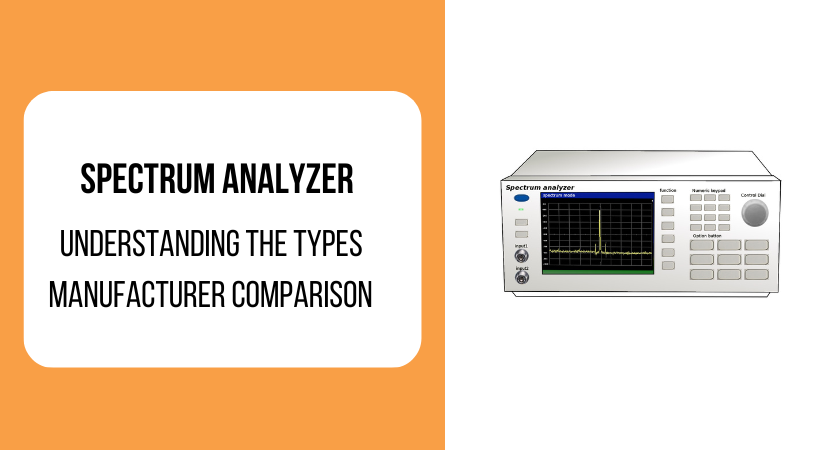However, there are many types, and many people may not know which measuring instrument to choose. Therefore, in this article, we will discuss the basics of spectrum analyzers, their types, and points to consider when selecting one.
目次
Spectrum analyzer features

A spectrum analyzer is a specialized measuring instrument that displays the relationship between frequency and power/voltage in a graph. You can measure signal frequency components, power, adjacent channel leakage power, etc. It is used for a variety of applications, including the design and evaluation of electronic circuits and communication equipment, and the detection of electromagnetic interference and obstacles.
Difference between spectrum analyzer and oscilloscope
The distinction between a spectrum analyzer and an oscilloscope lies in their unique methods of signal visualization. While a spectrum analyzer scrutinizes and presents the frequency content of a signal, an oscilloscope showcases signal changes over time.A spectrum analyzer is a tool for visualizing the frequency components of electronic signals, enabling in-depth analysis of frequency distribution, harmonics, noise, and other frequency-related data. Widely applied in fields like wireless communications, audio engineering, and electromagnetic compatibility (EMC) testing, spectrum analyzers play a pivotal role in signal analysis.
On the other hand, an oscilloscope focuses on illustrating variations in electrical signals across time, offering direct observation of parameters such as signal amplitude, period, phase, and waveform distortion. Indispensable across diverse industries including electrical engineering, telecommunications, and automotive sectors, oscilloscopes are vital for debugging, design validation, and electronic circuit maintenance.
Spectrum Analyzer Structure
A spectrum analyzer will be easier to understand if you know the basic structure of the “sweep type spectrum analyzer.”Structure of “Sweep Type Spectrum Analyzer”
- Attenuator: Responsible for attenuating the signal.
- Mixer: Multiplies the RF signal and LO signal, converting them into an IF signal.
- IF Filter: Eliminates noise from the mixer’s output and extracts the intermediate frequency (IF) signal, also known as the Resolution Band Width (RBW) filter.
- Logarithmic Amplifier: Special amplifier whose output signal corresponds to the logarithm of the input signal.
- Detector: Converts the signal amplified by the logarithmic amplifier into direct current.
- Video Filter: Low-pass filter that helps average out noise levels, enabling the detection of small peaks.
5 Types of Spectrum Analyzers, Features, Advantages and Disadvantages

There are two main types of spectrum analyzers. There is a sweep method using superheterodyne technology and a real-time method using digital technology.
- Analog sweep type spectrum analyzer
- Digital sweep type spectrum analyzer
- Multi-filter real-time spectrum analyzer
- Digital real-time spectrum analyzer
- USB connected spectrum analyzer
Characteristics of analog sweep type spectrum analyzer
A swept spectrum analyzer is a method that measures the frequency components and amplitude of a signal by sweeping a certain frequency range. The basic structure of a spectrum analyzer allows you to sweep a wideband spectrum in one go. It uses the same mechanism as a radio or receiver, and can only measure the targeted frequency range.Advantages of analog sweep type spectrum analyzer
Since the signal passes through an IF filter (RBW), the noise level is low. This measuring instrument is suitable when the measurement signal is stable or does not fluctuate significantly. It is especially good at sweeping a wide range of frequencies where the LO signal exceeds 1GHz.Disadvantages of analog sweep type spectrum analyzer
Only one frequency point can be measured at a time, so multiple frequency points cannot be measured simultaneously. If a signal suddenly occurs or fluctuates, data will be missed.Measurements also depend on frequency resolution (RBW). If you try to increase the resolution, the response will be slower and more difficult to measure. There is a trade-off relationship between measurement results and sweep speed, so appropriate settings are required.
Characteristics of digital sweep type spectrum analyzer
Analog systems are no longer able to keep up with the wide-ranging evolution of digital communications in recent years. Therefore, the digital sweep type spectrum analyzer was born.This is a measuring instrument that digitizes the input signal with an A/D converter and displays the frequency components using Fast Fourier Transform (FFT). It is also called a signal analyzer to distinguish it from the conventional analog type.
Advantages of digital sweep type spectrum analyzer
By converting digital signals into frequency components, three-dimensional measurements of time, frequency, and level are possible. Another major advantage is that Fast Fourier Transform (FFT) technology makes it possible to perform measurements all at once. It is also suitable for measuring unsteady signals over a short period of time.Digitization makes recording, playback, and sharing easier, and allows for calm analysis after measurement. The benefit of being able to analyze from various angles also contributed to the development of industry.
Disadvantages of digital sweep type spectrum analyzer
Although the benefits of digitalization have been enormous, there are also disadvantages. The digital measurement frequency range does not support signals from a few MHz to 100MHz. This is because the analysis frequency width of the digital method is determined by the IF filter bandwidth.Features of multi-filter real-time spectrum analyzer
A multi-filter real-time spectrum analyzer is a method of analyzing signals by arraying many filters consecutively along the frequency axis. Because a single signal passes through many filters, many signals can be processed in real time.It is used for octave analyzers, 1/3 octave analyzers, signals used in Bluetooth, sudden noises, burst signals, etc.
Advantages of multi-filter real-time spectrum analyzer
This is a spectrum analyzer that overcomes the weakness of swept-type spectrum analyzers: signals whose frequency changes over time. Because the analysis is performed through multiple filters at once, changing signals such as suddenly occurring noise can be observed without interruption.Disadvantages of multi-filter real-time spectrum analyzer
Since a large number of filters must be used, cost and size tend to be disadvantages.If the filter bandwidth is widened, it is possible to reduce the size with fewer filters, but the resolution may drop and the data may not be usable. Currently, it is only used for special purposes.
Characteristics of digital real-time spectrum analyzer
A digital real-time spectrum analyzer is a method that continuously captures and analyzes input signals. Perform digital frequency analysis using a Fourier transform machine in real time.Current real-time spectrum analyzers refer to this instrument. It is possible to accurately measure and analyze unsteady RF signals.
Advantages of digital real-time spectrum analyzer
A major advantage is that it can measure broadband information all at once. Also, by overlapping the timing of fast Fourier transform (FFT), you can reduce missing data.Even if the signal output time is short, it can be measured reliably, and it is possible to measure signals and noise that occur suddenly.
Disadvantages of digital real-time spectrum analyzer
Since the acquisition bandwidth is limited by the sampling rate of the A/D converter, there are also restrictions on span and resolution settings.Also, since a wide band can be captured all at once, the power of the entire band appears as noise. It may be difficult to measure if you are not used to it.
USB connected spectrum analyzer
A USB-connected spectrum analyzer is a type of spectrum analyzer that connects and operates via a PC’s USB port.The main unit is relatively small, and the spectrum analysis function can be used by installing dedicated software on a PC. This device uses internal electronic circuitry to process the signal, and software on a PC to display the signal’s spectrum and analyze it.
Ideal for mobile use, working in a space-saving environment, or when you want to keep costs down.
Advantages of USB-connected spectrum analyzer
USB-connected spectrum analyzers are small and lightweight, making them highly portable. Convenient for on-site measurements and on-the-go use.Additionally, compared to typical standalone spectrum analyzers, USB-connected types are often priced lower, making them suitable for those on a tight budget.
Disadvantages of USB connection (PC) spectrum analyzer
On the other hand, there may be limitations in terms of measurement performance and functionality. In particular, dynamic range, sensitivity, and frequency resolution may be limited.Also, since it is a USB connection, power supply from the PC being used is required. When used externally, your PC’s battery life may limit your work time.
So far, we have introduced the types of spectrum analyzers and their advantages and disadvantages. In the next section, we will introduce five criteria to compare when choosing a spectrum analyzer. Read on to the next section to choose the spectrum analyzer that’s right for your company.
Comparison criteria | How to choose a spectrum analyzer

What factors should you look for when choosing a new spectrum analyzer? Here we will introduce the factors you should pay attention to when purchasing.
- Measurement principles/functions
- Measurement frequency range
- Average noise level
- Resolution Bandwidth (RBW)
- Price
Measurement principles/functions
Sweep and real-time measurement instruments each have their own advantages and disadvantages. It is necessary to use them according to need.The sweep type has the advantage of lowering the noise level in the bandwidth you want to observe because it uses an IF filter to remove noise. However, it also has the disadvantage that there are many signal drops that occur intermittently.
On the other hand, the real-time method can analyze wideband signals in a single measurement. It has a high noise level and is not suitable for measuring signals with a large dynamic range.
Measurement frequency range
Spectrum analyzers come with specific frequency ranges for measurement. The frequencies available for analysis vary depending on the instrument type and its features, so it’s essential to consider this when making a purchase decision.It is important to note that the frequency range is often closely related to the selling price.
For instance, swept spectrum analyzers offer varying capabilities: analog types excel in measuring frequencies exceeding 1GHz, while digital types are optimal for frequencies ranging from several MHz to 100MHz.
Average noise level
DANL (Displayed Average Noise Level), is also known as Level. It is used to signify how small a signal a spectrum analyzer can measure. Signals below the notation cannot be read, so be sure to clarify which signal you want to measure.Resolution Bandwidth (RBW)
This refers to the bandwidth of the IF filter of a swept spectrum analyzer. There is a trade-off between measurement results and measurement speed. Make sure you are careful and select equipment with specifications that allow for appropriate settings depending on the application you wish to use them for.Price
When selecting a spectrum analyzer for purchase, it is important to aim for a balance between the available budget and the desired performance and functionality. Typically, price and performance go hand in hand, emphasizing the importance of choosing the right model based on intended usage, required accuracy, and functionality.Higher-priced spectrum analyzers often boast superior sensitivity, wider dynamic range, faster sweep speeds, and enhanced durability.
On the other hand, budget-friendly spectrum analyzers may offer only basic performance, limiting their ability to conduct advanced analyses or specialized measurements. However, they present a low initial investment, making them suitable for short-term use or cost-conscious projects.
Now that we have a better idea as to what kind of spectrum analyzer you might want, lets look into some well known companies with experience in manufacturing spectrum analyzers
Recommended manufacturers of spectrum analyzers

Let us now take a look at a few major manufacturers of spectrum analyzers.
- Micronics Co., Ltd.
- RIGOL Technologies Co., Ltd.
- Keysight Technologies, Inc.
- Ono Sokki Co., Ltd.
- Rohde & Schwarz Japan
- Texio Technology
Contact JET Global
Micronics Co., Ltd
Micronics develops electronic measurement, information communication, and environment-related equipment in the high frequency range. Although relatively small in size, it has performance and functions comparable to large bench type spectrum analyzers.RIGOL Technologies Co., Ltd
RIGOL Technologies Co.,Ltd. is a Chinese company founded in 1998. They develop and manufacture oscilloscopes, spectrum analyzers, signal generators, multimeters, DC power supplies, etc. They have obtained many patents in China, demonstrating their high technological capabilities and market compatibility.Keysight Technologies, Inc
Keysight Technologies is a U.S.-based manufacturer of electronic test and measurement equipment and the predecessor of the electronic test and measurement division of Hewlett-Packard (HP). With a history of over 80 years, their technological capabilities can be said to be among the highest rated in the world. This Japanese corporation is headquartered in Hachioji, Tokyo.Ono Sokki., Ltd
Ono Sokki is a manufacturer that develops and sells sensors, measurement equipment, software, etc. The spectrum analyzer uses a digital FFT method, and features a lineup that suits your needs, such as handheld type and PC type.Rohde & Schwarz Japan
A German company with three business divisions: electronic measurement, technology systems, and security. Their measurement accuracy is quite high, and the company has gained a lot of trust from engineers in the industry. They also sell spectrum analyzers that meet a variety of needs and are used in a range of different industries.Texio Technology
Texio Technology is a manufacturer specializing in DC stabilized power supplies and electronic measuring instruments. In addition to oscilloscopes and spectrum analyzers, they are also involved in the design and production of power supply related equipment and custom power supplies. Boasting years of experience in the field of spectrum analyzers and power supplies, this is a company that will definitely be an asset to your business.Improve your business efficiency with a spectrum analyzer
Even seemingly complicated frequencies can be analyzed efficiently if you can understand the principles of the measuring instrument and each component. Spectrum analyzers are tools that make your work more efficient, so choose one that suits your unique needs.Purchasing your own spectrum analyzer
Is the company really suitable for your business? Are you choosing the right model? Please feel free to contact us if you have any concerns.We will consider the differences between each product and company and suggest the option that best suits your business and its unique needs.
Contact JET Global

